2022 HYUNDAI ELANTRA HYBRID traction control
[x] Cancel search: traction controlPage 366 of 529
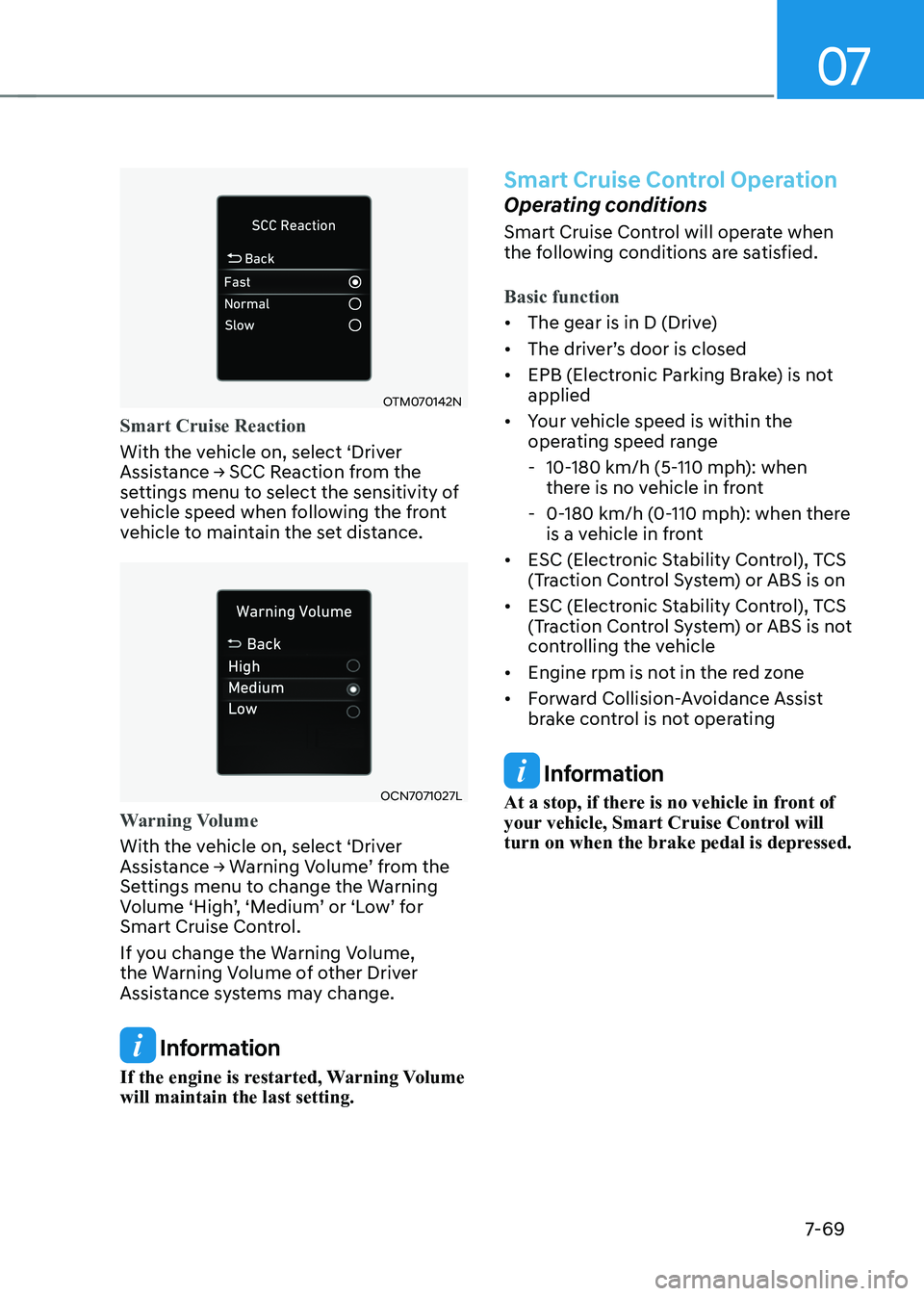
07
7-69
OTM070142N
Smart Cruise Reaction
With the vehicle on, select ‘Driver
Assistance → SCC Reaction from the
settings menu to select the sensitivity of
vehicle speed when following the front
vehicle to maintain the set distance.
OCN7071027L
Warning Volume
With the vehicle on, select ‘Driver
Assistance → Warning Volume’ from the
Settings menu to change the Warning
Volume ‘High’, ‘Medium’ or ‘Low’ for
Smart Cruise Control.
If you change the Warning Volume,
the Warning Volume of other Driver
Assistance systems may change.
Information
If the engine is restarted, Warning Volume will maintain the last setting.
Smart Cruise Control Operation
Operating conditions
Smart Cruise Control will operate when
the following conditions are satisfied.
Basic function
• The gear is in D (Drive)
• The driver’s door is closed • EPB (Electronic Parking Brake) is not applied
• Your vehicle speed is within the
operating speed range
- 10-180 km/h (5-110 mph): when there is no vehicle in front
- 0-180 km/h (0-110 mph): when there is a vehicle in front
• ESC (Electronic Stability Control), TCS
(Traction Control System) or ABS is on
• ESC (Electronic Stability Control), TCS
(Traction Control System) or ABS is not
controlling the vehicle
• Engine rpm is not in the red zone
• Forward Collision-Avoidance Assist
brake control is not operating
Information
At a stop, if there is no vehicle in front of
your vehicle, Smart Cruise Control will
turn on when the brake pedal is depressed.
Page 451 of 529
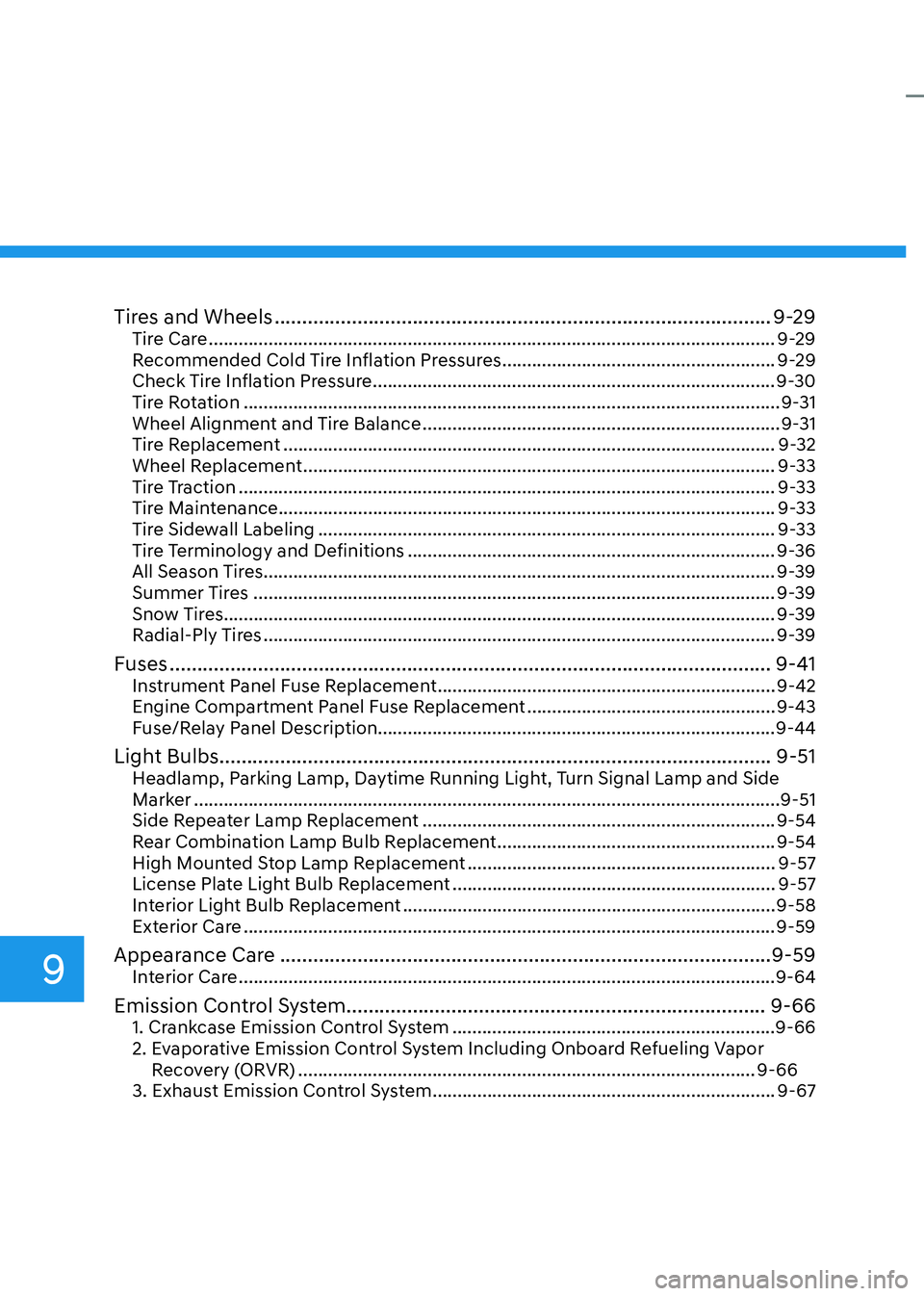
Tires and Wheels .......................................................................................... 9-29Tire Care .................................................................................................................. 9-29
Recommended Cold Tire Inflation Pressures ....................................................... 9-29
Check Tire Inflation Pressure ................................................................................. 9-30
Tire Rotation ............................................................................................................ 9-31
Wheel Alignment and Tire Balance ........................................................................ 9-31
Tire Replacement ................................................................................................... 9-32
Wheel Replacement ............................................................................................... 9-33
Tire Traction ............................................................................................................ 9-33
Tire Maintenance.................................................................................................... 9-33
Tire Sidewall Labeling ............................................................................................ 9-33
Tire Terminology and Definitions .......................................................................... 9-36
All Season Tires ....................................................................................................... 9-39
Summer Tires ......................................................................................................... 9-39
Snow Tires............................................................................................................... 9-39
Radial-Ply Tires ....................................................................................................... 9-39
Fuses ............................................................................................................. 9-41 Instrument Panel Fuse Replacement .................................................................... 9-42
Engine Compartment Panel Fuse Replacement .................................................. 9-43
Fuse/Relay Panel Description................................................................................9-44
Light Bulbs .................................................................................................... 9-51 Headlamp, Parking Lamp, Daytime Running Light, Turn Signal Lamp and Side
Marker ......................................................................................................................9- 51
Side Repeater Lamp Replacement ....................................................................... 9-54
Rear Combination Lamp Bulb Replacement ........................................................ 9-54
High Mounted Stop Lamp Replacement .............................................................. 9-57
License Plate Light Bulb Replacement ................................................................. 9-57
Interior Light Bulb Replacement ...........................................................................9-58
Exterior Care ........................................................................................................... 9-59
Appearance Care .........................................................................................9-59 Interior Care ............................................................................................................9-64
Emission Control System ............................................................................ 9-66 1. Crankcase Emission Control System .................................................................9-66
2. Evaporative Emission Control System Including Onboard Refueling Vapor Recovery (ORVR) ............................................................................................ 9-66
3. Exhaust Emission Control System ..................................................................... 9-67
9
Page 482 of 529
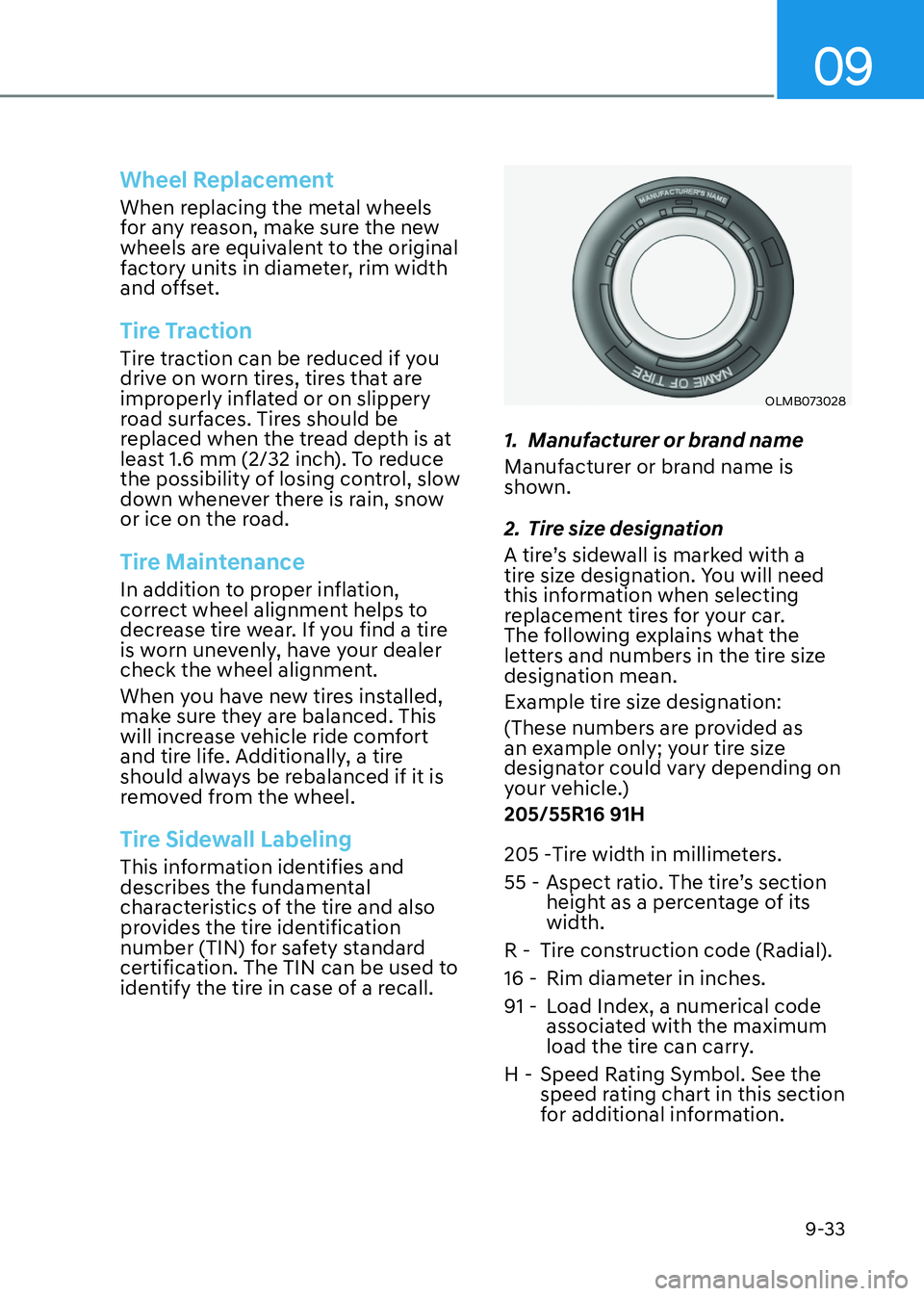
09
9-33
Wheel Replacement
When replacing the metal wheels
for any reason, make sure the new
wheels are equivalent to the original
factory units in diameter, rim width
and offset.
Tire Traction
Tire traction can be reduced if you
drive on worn tires, tires that are
improperly inflated or on slippery
road surfaces. Tires should be
replaced when the tread depth is at
least 1.6 mm (2/32 inch). To reduce
the possibility of losing control, slow
down whenever there is rain, snow
or ice on the road.
Tire Maintenance
In addition to proper inflation,
correct wheel alignment helps to
decrease tire wear. If you find a tire
is worn unevenly, have your dealer
check the wheel alignment.
When you have new tires installed,
make sure they are balanced. This
will increase vehicle ride comfort
and tire life. Additionally, a tire
should always be rebalanced if it is
removed from the wheel.
Tire Sidewall Labeling
This information identifies and
describes the fundamental
characteristics of the tire and also
provides the tire identification
number (TIN) for safety standard
certification. The TIN can be used to
identify the tire in case of a recall.
OLMB073028OLMB073028
1. Manufacturer or brand name
Manufacturer or brand name is
shown.
2. Tire size designation
A tire’s sidewall is marked with a
tire size designation. You will need
this information when selecting
replacement tires for your car.
The following explains what the
letters and numbers in the tire size
designation mean.
Example tire size designation:
(These numbers are provided as
an example only; your tire size
designator could vary depending on
your vehicle.) 205/55R16 91H
205 -Tire width in millimeters.
55 - Aspect ratio. The tire’s section height as a percentage of its width.
R - Tire construction code (Radial).
16 - Rim diameter in inches.
91 - Load Index, a numerical code associated with the maximum
load the tire can carry.
H - Speed Rating Symbol. See the speed rating chart in this section
for additional information.
Page 484 of 529
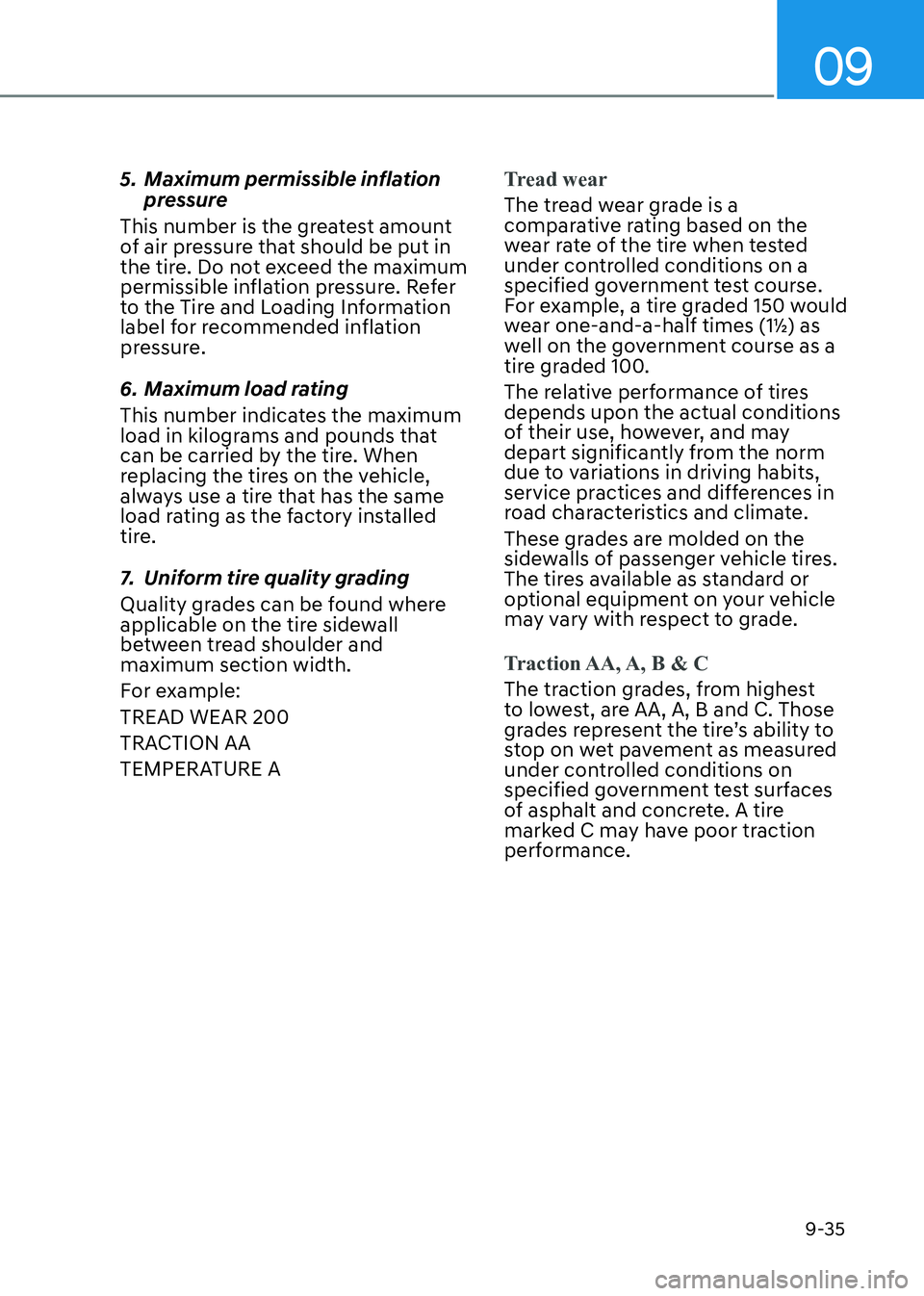
09
9-35
5. Maximum permissible inflation
pressure
This number is the greatest amount
of air pressure that should be put in
the tire. Do not exceed the maximum
permissible inflation pressure. Refer
to the Tire and Loading Information
label for recommended inflation
pressure.
6. Maximum load rating
This number indicates the maximum
load in kilograms and pounds that
can be carried by the tire. When
replacing the tires on the vehicle,
always use a tire that has the same
load rating as the factory installed
tire.
7. Uniform tire quality grading
Quality grades can be found where
applicable on the tire sidewall
between tread shoulder and maximum section width.
For example:TREAD WEAR 200
TRACTION AA
TEMPERATURE A
Tread wear
The tread wear grade is a
comparative rating based on the
wear rate of the tire when tested
under controlled conditions on a
specified government test course.
For example, a tire graded 150 would
wear one-and-a-half times (1½) as
well on the government course as a
tire graded 100.
The relative performance of tires depends upon the actual conditions
of their use, however, and may
depart significantly from the norm
due to variations in driving habits,
service practices and differences in
road characteristics and climate.
These grades are molded on the
sidewalls of passenger vehicle tires.
The tires available as standard or
optional equipment on your vehicle
may vary with respect to grade.
Traction AA, A, B & C
The traction grades, from highest
to lowest, are AA, A, B and C. Those
grades represent the tire’s ability to
stop on wet pavement as measured
under controlled conditions on
specified government test surfaces
of asphalt and concrete. A tire
marked C may have poor traction
performance.
Page 485 of 529
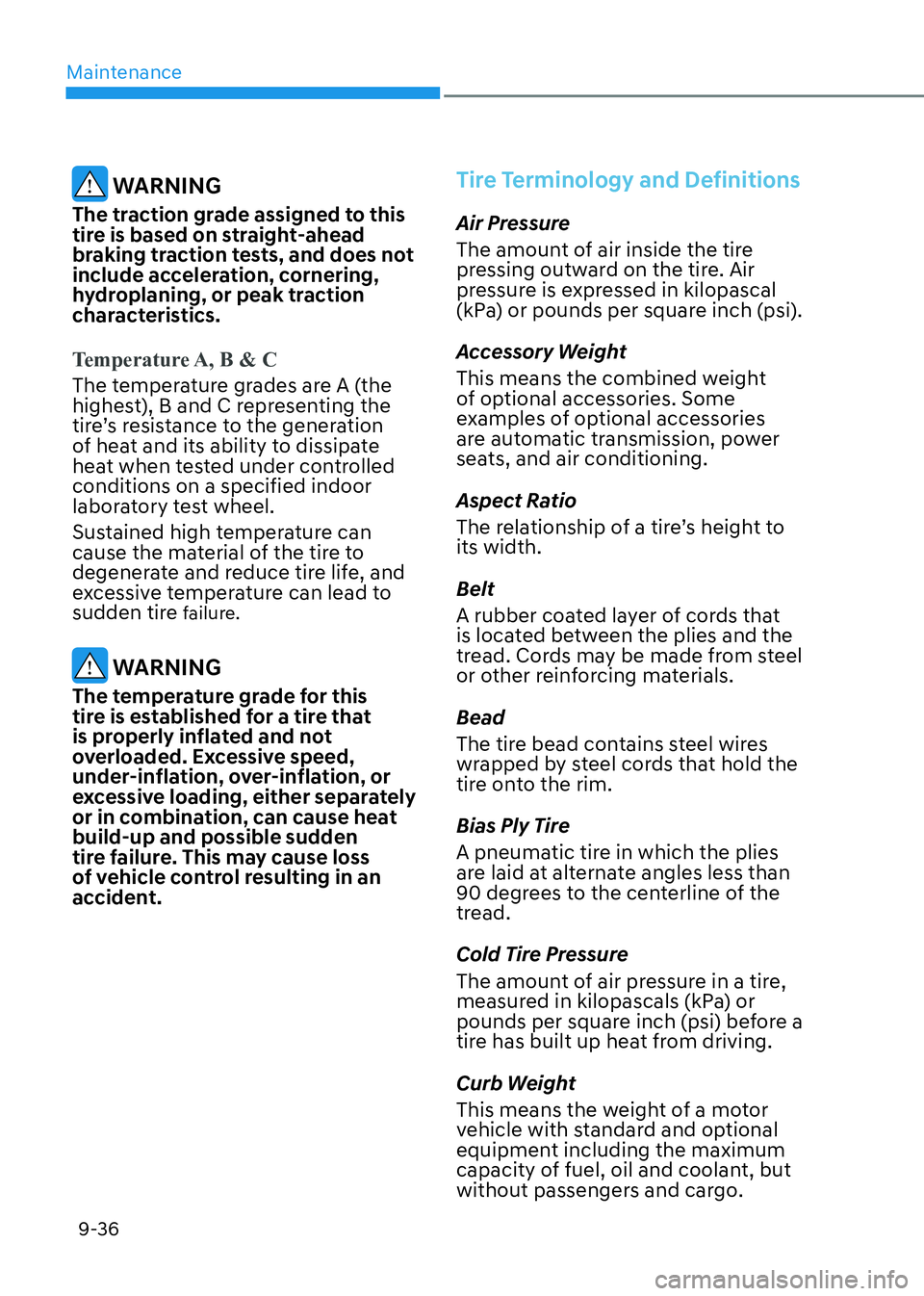
Maintenance
9-36
WARNING
The traction grade assigned to this
tire is based on straight-ahead
braking traction tests, and does not
include acceleration, cornering,
hydroplaning, or peak traction
characteristics.
Temperature A, B & C
The temperature grades are A (the
highest), B and C representing the
tire’s resistance to the generation
of heat and its ability to dissipate
heat when tested under controlled conditions on a specified indoor
laboratory test wheel.
Sustained high temperature can
cause the material of the tire to
degenerate and reduce tire life, and
excessive temperature can lead to
sudden tire failure.
WARNING
The temperature grade for this
tire is established for a tire that
is properly inflated and not
overloaded. Excessive speed,
under-inflation, over-inflation, or
excessive loading, either separately
or in combination, can cause heat build-up and possible sudden
tire failure. This may cause loss
of vehicle control resulting in an accident.
Tire Terminology and Definitions
Air Pressure
The amount of air inside the tire
pressing outward on the tire. Air
pressure is expressed in kilopascal
(kPa) or pounds per square inch (psi).
Accessory Weight
This means the combined weight
of optional accessories. Some
examples of optional accessories
are automatic transmission, power
seats, and air conditioning.
Aspect Ratio
The relationship of a tire’s height to its width. Belt
A rubber coated layer of cords that
is located between the plies and the
tread. Cords may be made from steel
or other reinforcing materials. Bead
The tire bead contains steel wires
wrapped by steel cords that hold the
tire onto the rim.
Bias Ply Tire
A pneumatic tire in which the plies
are laid at alternate angles less than
90 degrees to the centerline of the
tread.
Cold Tire Pressure
The amount of air pressure in a tire,
measured in kilopascals (kPa) or
pounds per square inch (psi) before a
tire has built up heat from driving.
Curb Weight
This means the weight of a motor
vehicle with standard and optional equipment including the maximum
capacity of fuel, oil and coolant, but
without passengers and cargo.
Page 488 of 529
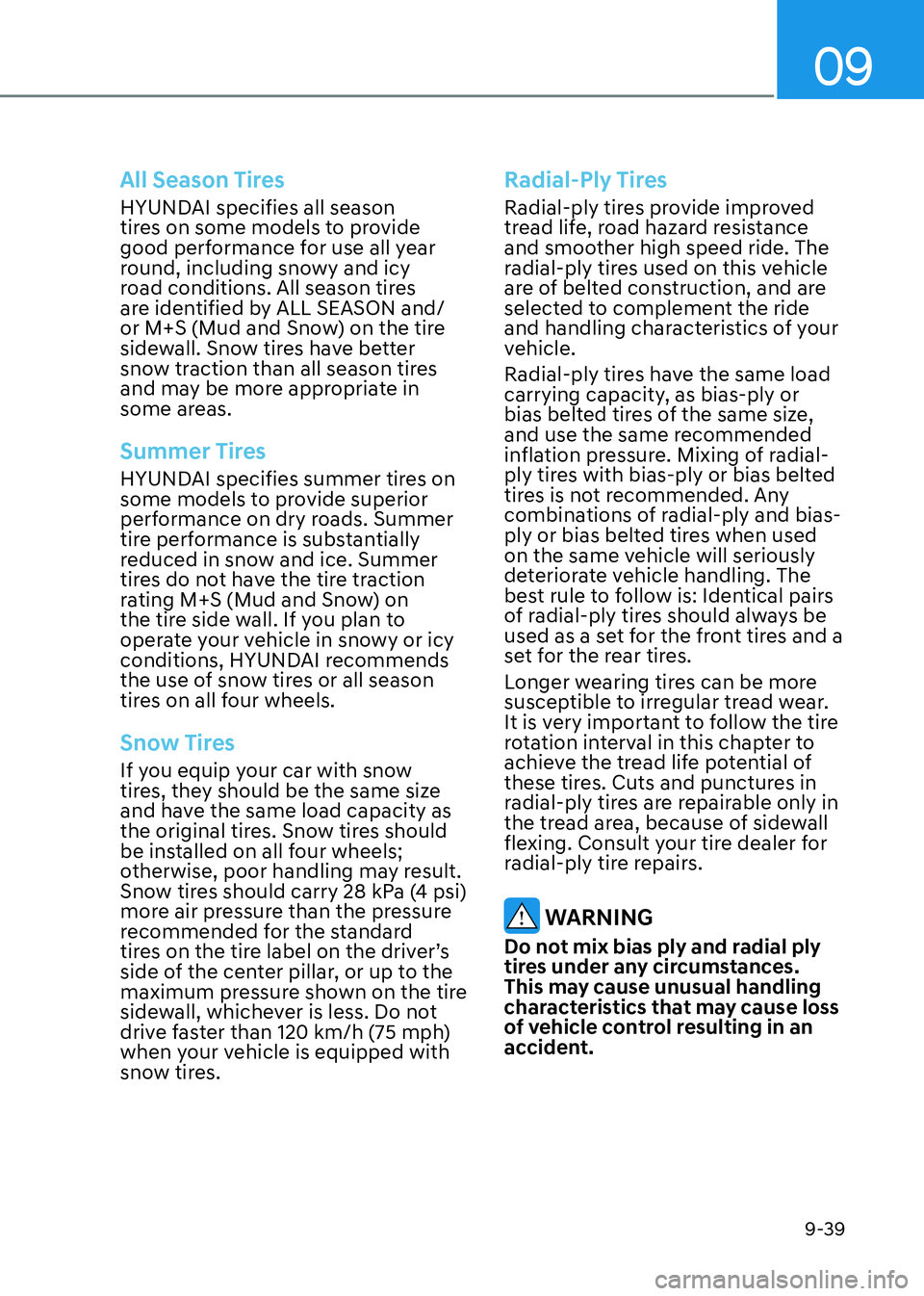
09
9-39
All Season Tires
HYUNDAI specifies all season
tires on some models to provide
good performance for use all year
round, including snowy and icy
road conditions. All season tires
are identified by ALL SEASON and/
or M+S (Mud and Snow) on the tire
sidewall. Snow tires have better
snow traction than all season tires
and may be more appropriate in
some areas.
Summer Tires
HYUNDAI specifies summer tires on
some models to provide superior
performance on dry roads. Summer
tire performance is substantially
reduced in snow and ice. Summer
tires do not have the tire traction
rating M+S (Mud and Snow) on
the tire side wall. If you plan to
operate your vehicle in snowy or icy
conditions, HYUNDAI recommends
the use of snow tires or all season
tires on all four wheels.
Snow Tires
If you equip your car with snow
tires, they should be the same size
and have the same load capacity as
the original tires. Snow tires should
be installed on all four wheels;
otherwise, poor handling may result.
Snow tires should carry 28 kPa (4 psi)
more air pressure than the pressure
recommended for the standard
tires on the tire label on the driver’s
side of the center pillar, or up to the
maximum pressure shown on the tire
sidewall, whichever is less. Do not
drive faster than 120 km/h (75 mph)
when your vehicle is equipped with
snow tires.
Radial-Ply Tires
Radial-ply tires provide improved
tread life, road hazard resistance
and smoother high speed ride. The
radial-ply tires used on this vehicle
are of belted construction, and are
selected to complement the ride
and handling characteristics of your
vehicle.
Radial-ply tires have the same load
carrying capacity, as bias-ply or
bias belted tires of the same size,
and use the same recommended
inflation pressure. Mixing of radial-
ply tires with bias-ply or bias belted
tires is not recommended. Any
combinations of radial-ply and bias-
ply or bias belted tires when used
on the same vehicle will seriously
deteriorate vehicle handling. The
best rule to follow is: Identical pairs
of radial-ply tires should always be
used as a set for the front tires and a
set for the rear tires.
Longer wearing tires can be more
susceptible to irregular tread wear.
It is very important to follow the tire
rotation interval in this chapter to
achieve the tread life potential of
these tires. Cuts and punctures in
radial-ply tires are repairable only in
the tread area, because of sidewall
flexing. Consult your tire dealer for
radial-ply tire repairs.
WARNING
Do not mix bias ply and radial ply
tires under any circumstances.
This may cause unusual handling
characteristics that may cause loss
of vehicle control resulting in an accident.
Page 523 of 529
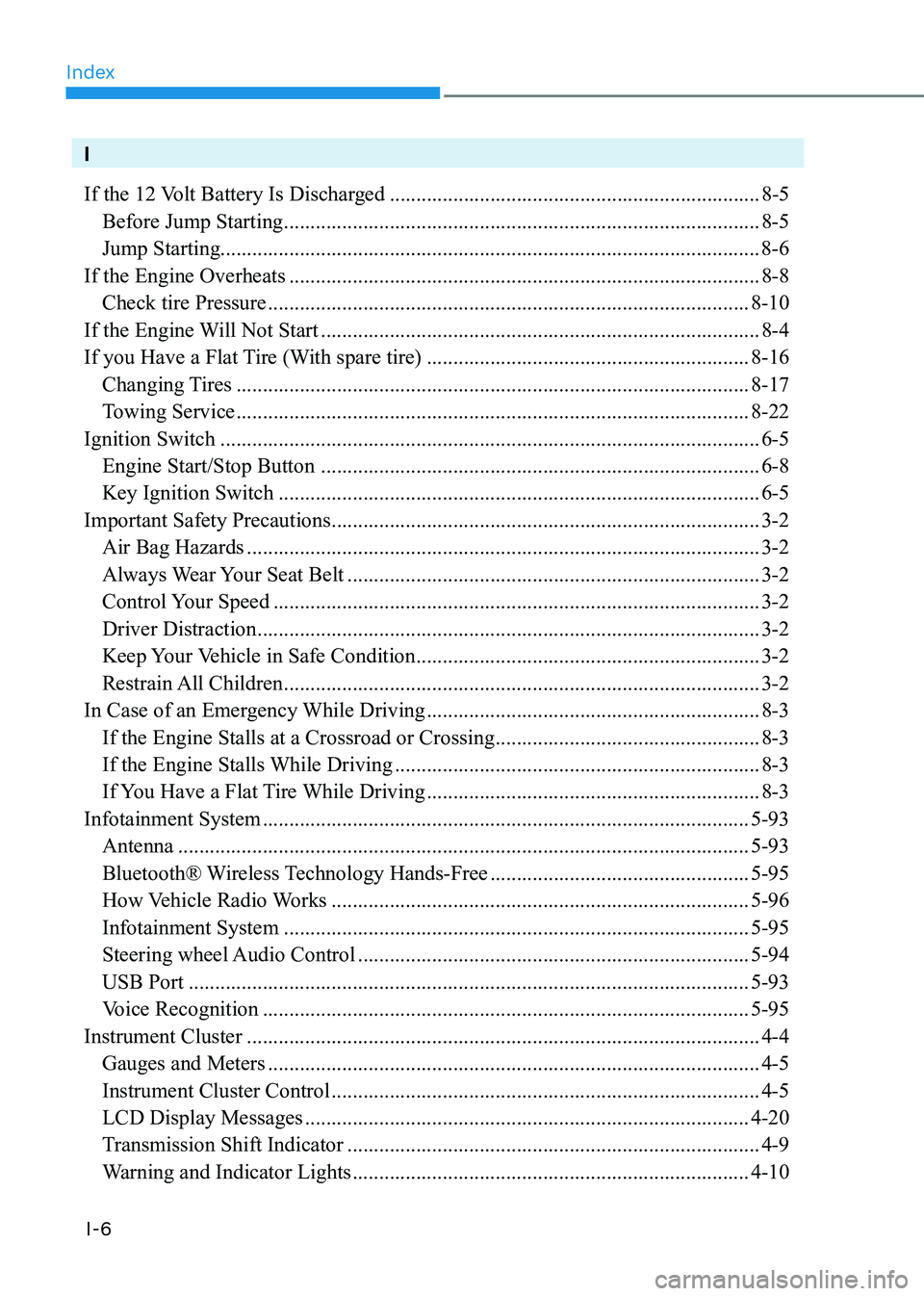
Index
I-6
I
If the 12 Volt Battery Is Discharged ...................................................................... 8-5
Before Jump Starting .......................................................................................... 8-5
Jump Starting...................................................................................................... 8-6 If the Engine Overheats ......................................................................................... 8-8
Check tire Pressure ........................................................................................... 8-10
If the Engine Will Not Start ................................................................................... 8-4
If you Have a Flat Tire (With spare tire) .............................................................8-16
Changing Tires ................................................................................................. 8-17
Towing Service ................................................................................................. 8-22
Ignition Switch ...................................................................................................... 6-5
Engine Start/Stop Button ................................................................................... 6-8
Key Ignition Switch ........................................................................................... 6-5
Important Safety Precautions ................................................................................. 3-2
Air Bag Hazards ................................................................................................. 3-2
Always Wear Your Seat Belt .............................................................................. 3-2
Control Your Speed ............................................................................................ 3-2
Driver Distraction ............................................................................................... 3-2
Keep Your Vehicle in Safe Condition ................................................................. 3-2
Restrain All Children .......................................................................................... 3-2
In Case of an Emergency While Driving ...............................................................8-3
If the Engine Stalls at a Crossroad or Crossing ..................................................8-3
If the Engine Stalls While Driving ..................................................................... 8-3
If You Have a Flat Tire While Driving ...............................................................8-3
Infotainment System ............................................................................................ 5-93
Antenna ............................................................................................................ 5-93
Bluetooth® Wireless Technology Hands-Free .................................................5-95
How Vehicle Radio Works ............................................................................... 5-96
Infotainment System ........................................................................................ 5-95
Steering wheel Audio Control .......................................................................... 5-94
USB Port .......................................................................................................... 5-93
Voice Recognition ............................................................................................ 5-95
Instrument Cluster ................................................................................................. 4-4
Gauges and Meters ............................................................................................. 4-5
Instrument Cluster Control ................................................................................. 4-5
LCD Display Messages .................................................................................... 4-20
Transmission Shift Indicator .............................................................................. 4-9
Warning and Indicator Lights ........................................................................... 4-10